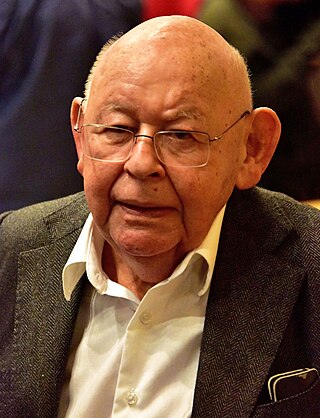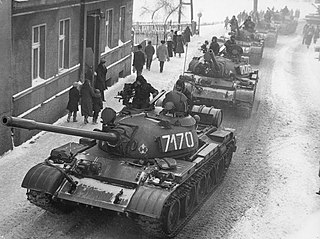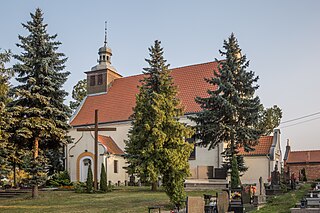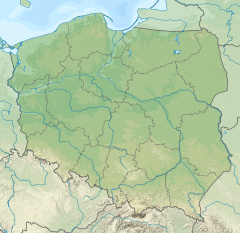
Gdańsk is a city on the Baltic coast of northern Poland. With a population of 470,621, Gdańsk is the capital and largest city of the Pomeranian Voivodeship. It is Poland's principal seaport and the country's fourth-largest metropolitan area.
The Polish People's Party is an agrarian political party in Poland. It is currently led by Władysław Kosiniak-Kamysz.

Łódź, also seen without diacritics as Lodz, is a city in central Poland and a former industrial centre. It is the capital of Łódź Voivodeship, and is located approximately 120 km (75 mi) south-west of Warsaw. The city's coat of arms is an example of canting, as it depicts a boat, which alludes to the city's name. As of 2022, Łódź has a population of 670,642 making it the country's fourth largest city.

The Polish People's Republic was a country in Central Europe that existed from 1947 to 1989 as the predecessor of the modern Republic of Poland. With a population of approximately 37.9 million near the end of its existence, it was the second most-populous communist and Eastern Bloc country in Europe. Having a unitary Marxist–Leninist government, it was also one of the main signatories of the Warsaw Pact alliance. The largest city and official capital since 1947 was Warsaw, followed by the industrial city of Łódź and cultural city of Kraków. The country was bordered by the Baltic Sea to the north, the Soviet Union to the east, Czechoslovakia to the south, and East Germany to the west.

Radomskopronounced [raˈdɔmskɔ] is a city in southern Poland with 44,700 inhabitants (2021). It is situated on the Radomka river in the Łódź Voivodeship, having previously been in Piotrków Trybunalski Voivodeship (1975–1998). It is the county seat of Radomsko county.

Witold Pilecki was a Polish World War II cavalry officer, intelligence agent, and resistance leader.

The Battle of Westerplatte was the first battle of the German invasion of Poland, marking the start of World War II in Europe. It occurred on the Westerplatte peninsula in the harbour of the Free City of Danzig.

Jerzy Urban was a Polish journalist, commentator, writer and politician, best known as the founder and editor-in-chief of the weekly magazine Nie. From 1981 to 1989 he was the Press Secretary of the Communist government under the Polish People's Republic, and the Head of the Polish Radio and Television Committee in 1989.

Martial law in Poland existed between 13 December 1981 and 22 July 1983. The government of the Polish People's Republic drastically restricted everyday life by introducing martial law and a military junta in an attempt to counter political opposition, in particular the Solidarity movement.

The Canadian-Polish Congress is a Canadian not-for-profit organization federally integrated on the 7th of February 1933 in Winnipeg, Manitoba which was previously known as the Federation of Polish Societies in Canada. The Canadian Polish Congress serves as the central umbrella organization for some 150 affiliated Polish-Canadian social, cultural, charitable, educational and professional organizations throughout Canada. The organisation listed on the WM Fares Wall of Tribute was founded in 1944, it is the main advocacy group for the Polish community in Canada and promotes awareness of Poland's history and cultural heritage, and the contribution of Polish Canadians to Canadian institutions, culture and society. Its subdivided area of activity spreads all over Canada and includes districts of Alberta, British Columbia, Manitoba, Ontario and Quebec.

The National Museum in Warsaw, popularly abbreviated as MNW, is a national museum in Warsaw, one of the largest museums in Poland and the largest in the capital. It comprises a rich collection of ancient art, counting about 11,000 pieces, an extensive gallery of Polish painting since the 16th century and a collection of foreign painting including some paintings from Adolf Hitler's private collection, ceded to the museum by the American authorities in post-war Germany. The museum is also home to numismatic collections, a gallery of applied arts and a department of oriental art, with the largest collection of Chinese art in Poland, comprising some 5,000 objects.

Górsk is a village in the administrative district of Gmina Zławieś Wielka, within Toruń County, Kuyavian-Pomeranian Voivodeship, in north-central Poland. It lies approximately 14 km (9 mi) west of Toruń and 30 km (19 mi) east of Bydgoszcz. It is located in Chełmno Land within the historic region of Pomerania.

POLIN Museum of the History of Polish Jews is a museum on the site of the former Warsaw Ghetto. The Hebrew word Polin in the museum's English name means either "Poland" or "rest here" and relates to a legend about the arrival of the first Jews to Poland.

The looting of Polish cultural artifacts and industrial infrastructure during World War II was carried out by Nazi Germany and the Soviet Union simultaneously after the invasion of Poland of 1939. A significant portion of Poland's cultural heritage, estimated at about half a million art objects, was plundered by the occupying powers. Catalogued pieces are still occasionally recovered elsewhere in the world and returned to Poland.
The Museum of John Paul II and Primate Wyszyński is a Roman Catholic cultural and educational institution affiliated with the Archdiocese of Warsaw, honoring two prominent Polish Catholic leaders: Saint John Paul II, the first Polish Pope, and Cardinal Stefan Wyszyński, the Archbishop of Warsaw and Gniezno and Primate of Poland. It was established by a decree of 18 May 2010 issued by Archbishop Kazimierz Nycz.

Patryk Tomasz Jaki is a Polish politician, member of the European Parliament, former Secretary of State in the Ministry of Justice and First Deputy Attorney General, former Chairman of the Verification Committee for Reprivatisation since 2017.

The Warsaw Ghetto Museum is a historical museum in Warsaw currently under construction.
After the end of World War II, the Communist government in Poland instituted large scale nationalizations in Poland starting in 1944.

Jan Krzysztof Żaryn is a Polish historian, professor and politician, who was a Senator in the Senate of Poland from 2015 to 2019.

Dziennik Telewizyjny, commonly simplified to Dziennik, was the chief news program of Telewizja Polska between 1958 and 1989, in the Polish People's Republic. It was Poland's second regularly televised newscast and the primary propaganda tool used by the Polish United Workers' Party during the Cold War. The final episode aired on 17 November 1989 and the program was replaced by Wiadomości on the following day, 18 November 1989.


















